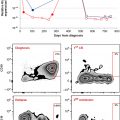Treatment of Multiple Myeloma
Dana-Farber Cancer Institute, Boston, MA, USA
Prognostic Markers
Introduction
Multiple myeloma is a heterogeneous disease with both patient- and tumor-specific factors playing a role in predicting outcome. Overall survival in multiple myeloma is variable, with a current median of 7 to 10 years. Understanding both host- and tumor-derived factors is crucial for risk stratification, predicting outcome, and thus optimizing choices in therapy.
Prognostic markers can provide information about the aggressiveness of underlying disease and provide an assessment of risk when selecting potential treatment regimens.
Mutiple Choice Questions
1. What is the median overall survival of patients classified as standard risk?
- 12 months
- 24 months
- 42 months
- 80 months
Overall, patients with standard-risk myeloma have a median OS of 7 years.
2. What genetic abnormalities make up the intermediate-risk group? (Choose all that apply)
- t(4;14)
- t(11;14)
- t(6;14)
- t(14;20)
- del 17p
- Hyperdiploidy
- Hypodiploidy
- del13
t(4;14)
Several studies have shown that t(4;14) is associated with poor OS. Jaksic et al. (2005) determined that t(4;14)-positive patients are chemotherapy sensitive with 90% of patients achieving a partial response to VAD (vincristine, doxorubicin, and dexamethasone) therapy; however, early progression was common, with 26% of patients progressing before transplant and a median progression-free survival of only 14.1 months after transplant. More importantly, at relapse, resistance to alkylating agents was observed.
With the introduction of novel agents, San Miguel et al. (2008) compared the use of melphalan and prednisone with or without bortezomib in untreated patients with multiple myeloma who were ineligible for high-dose therapy. The efficacy of bortezomib therapy was evaluated in 26 patients with high-risk cytogenetics specifically, (t(4;14),t(14;16) translocation or 17p deletion). When compared to 142 patients with standard-risk cytogenetics, patients with t(4;14) had similar complete response rates (26%) with similar times to progression (P = 0.55) and OS (P = 0.99). It was concluded that the adverse prognosis of t(4;14) could be overcome with bortezomib therapy, and lenalidomide-based regimens have similarly been reported to be active in such patients; hence, this abnormality is now classified as intermediate risk rather than high risk in the 2012 update on the management and risk stratification of multiple myeloma.
Del 13q14
The presence of a 13q14 deletion used to be associated with significantly worse prognosis. This adverse prognostic factor was found to be independent of chemotherapy or high-dose therapy using single or tandem autologous transplantation, with multivariate analysis confirming the independent predictive value of 13q14 deletions for shortened survival. Its presence was also associated with a lower rate of response to chemotherapy. Deletions of 13q14 correlate with increased proliferative activity. However, the adverse prognostic impact of del(13) is less pronounced when detected by FISH than by conventional cytogenetics, which may be related to the potentially greater association between elevated plasma cell proliferation and del13 detected by metaphase cytogenetics. Treatment incorporating bortezomib may overcome the negative prognostic effects of del13 and produce outcomes independent of this mutation. Therefore, although previously considered high risk, as in t(4;14), deletion 13 is now classified as intermediate risk in the 2012 update on the management and risk stratification of multiple myeloma.
Hypodiploidy
Historically, patients with hypodiploid content had poorer responses to chemotherapy and shorter OS in several studies. Using univariate analysis, Smadja et al. (2001) found that among all the different chromosomal abnormalities, the chromosome number was the most important prognostic factor, with a median OS of 33.8 months for hyperdiploid patients compared with 12.5 months for hypodiploid patients (P < .001).
3. What is the median overall survival of patients classified in the intermediate-risk group?
- 12 months
- 24 months
- 42 months
- 80 months
- 100 months
Overall, patients with intermediate-risk myeloma have a median OS of 42 months.
4. What genetic abnormalities make up the high-risk group? (Choose all that apply)
- t(4;14)
- t(11;14)
- t(6;14)
- t(14;20)
- del 17p
- Hyperdiploidy
- Hypodiploidy
- del13
- t(14;16)
17p13
Although deletion of 17p is less frequently found in myeloma patients as compared to other malignancies, it continues to be a poor prognostic factor. The presence of 17p mutation is associated with significantly shorter OS (median 24.7 months), with serum levels of both beta 2-microglobulin and calcium higher in patients with deletion 17p, and a significant association with soft tissue plasmacytomas, as well as central nervous system involvement in rare instances.
t(14;16)
An initial series reported that t(14;16) was associated with a poor prognosis, despite the early incorporation of chemotherapy agents and tandem autologous transplantation. This translocation is associated with more aggressive underlying disease activity.
5. What is the median OS of patients classified in the high-risk group?







